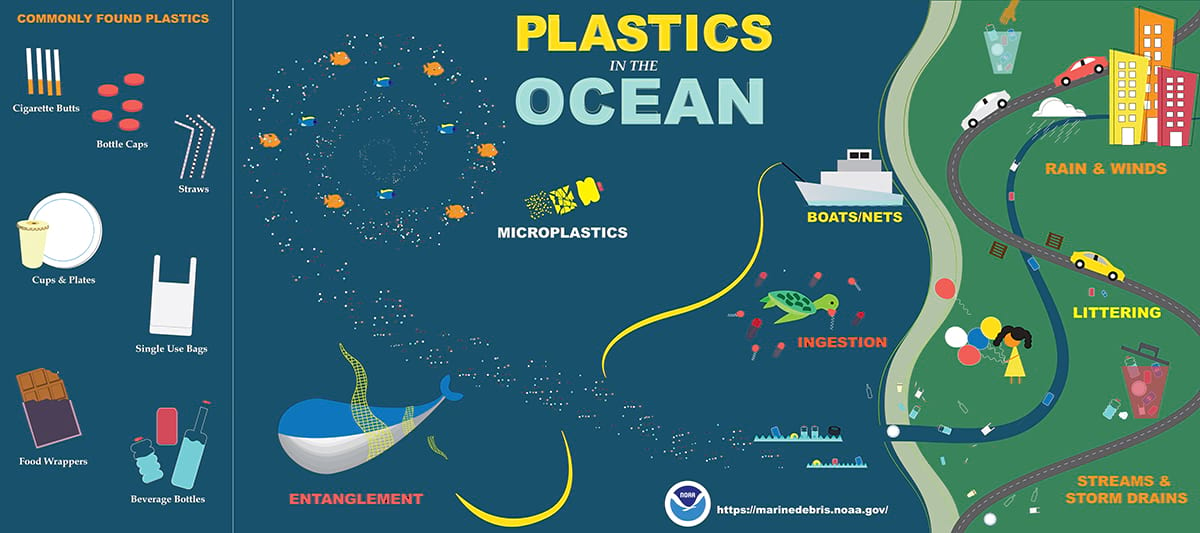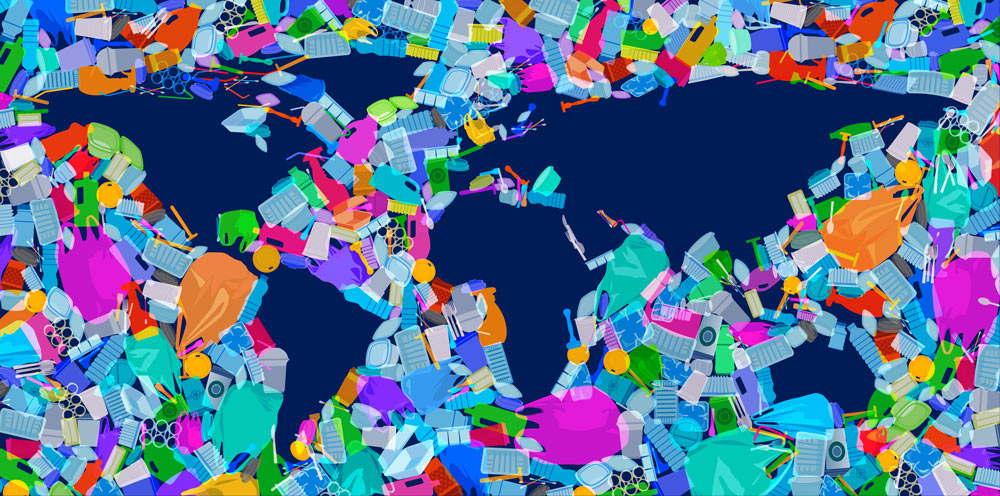PLASTIC IS EVERYWHERE: In your home, your office, your school — and your ocean. Among the top 10 kinds of trash picked up during the 2017 International Coastal Cleanup were food wrappers, beverage bottles, grocery bags, straws and take out containers, all made of plastic. How did it all get there? Why is it a problem? What can we do?
While it’s difficult to say exactly how much plastic is in the ocean, scientists think there’s about 8 million metric tons of plastic making its way there every year. That’s the weight of nearly 90 aircraft carriers. These plastics come in many different forms. Just think about all the plastic items you use daily: the toothbrush you grab first thing in the morning, the container your lunch comes in or the bottle you drink water from after your workout. All these things get used and, eventually, thrown out. Many plastic products are single-use items that are designed to be thrown out, like water bottles or take-out containers. These are used and discarded quickly. If this waste isn’t properly disposed of or managed, it can end up in the ocean.
Unlike some other kinds of waste, plastic doesn’t decompose. That means plastic can stick around indefinitely, wreaking havoc on marine ecosystems. Some plastics float once they enter the ocean, though not all do. As the plastic is tossed around, much of it breaks into tiny pieces, called microplastics. While photodegradable plastics (plastics capable of being broken down by light) may break down from its first state (or created state), these plastics never completely degrade, but actually divide into microplastics. Microplastics are the multi-colored pieces of plastic that can be found in a handful of sand on the beach or in the ocean. Scientists are still investigating the impact of microplastics on our ocean and marine life.
Microfibers, shed from synthetic clothing or fishing nets, are another problematic form of microplastic. Microplastics less than 5mm in size can come from large plastics breaking down or can be produced as small plastics such as microbeads, which can be found in products such as toothpaste and face wash. These fibers, beads and microplastic fragments can all absorb harmful pollutants like pesticides, dyes and flame-retardants, only to later release them in the ocean.
NOAA’s Marine Debris Program (MDP) works to understand how plastics — and other marine debris — get into the ocean, how they can be removed and how they can be kept from polluting the marine environment in the future. The NOAA MDP envisions the global ocean and its coasts free from the impacts of marine debris with its mission to investigate and prevent the adverse impacts of marine debris. The NOAA MDP has developed a strategic plan to succeed in continuing to combat marine debris in the coming years.
Learn more at marinedebris.noaa.gov.
The program is authorized by Congress to work on marine debris through the Marine Debris Act, signed into law in 2006 and amended in 2012 and 2018. The Interagency Marine Debris Coordinating Committee (IMDCC) is a multi-agency body responsible for streamlining the federal government’s efforts to address marine debris.
What can you do?
There are many ways to keep plastic out of the ocean but here are two strategies:
Reduce plastic use.
Look around you and think about all the plastic items you use every day. How many plastic things can you see? Being more aware of how and why you use the plastics that you do is the first step to reducing plastic use. Commit to changing your habits by reducing your use of disposable and single-use plastic items, reusing items and/or recycling them. Participate in a cleanup.
Volunteer to pick up marine litter in your local community.
To find a cleanup near you, visit oceanconservancy.org.
Find out more at oceanservice.noaa.gov/hazards/marinedebris/plastics-in-the-ocean.
 Commonly found plastics include cigarette butts, food wrappers, beverage bottles, straws, cups and plates, bottle caps and single-use bags.
Commonly found plastics include cigarette butts, food wrappers, beverage bottles, straws, cups and plates, bottle caps and single-use bags.
How to help: Reduce, reuse, recycle. Dispose of waste properly no matter where you are. Get involved and participate in local cleanups in your area. Remember that our land and sea are connected.
Impacts include: Entanglement — Marine life can get caught and killed in derelict fishing nets and other plastic debris; Ingestion — Animals can easily mistake plastic debris for food.
Sources include: Boats/nets — Fishing gear can become marine debris when it is lost or abandoned; Littering — Intentional littering or improper disposal of trash can cause marine debris.
Debris can enter the water via: Rain and winds can sweep debris into nearby waters; streams and storm drains can carry debris directly into the ocean or Great Lakes.






